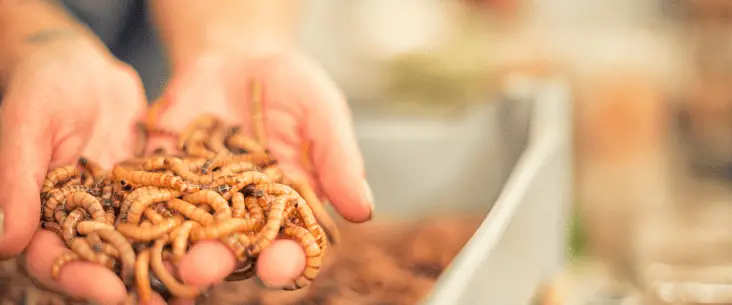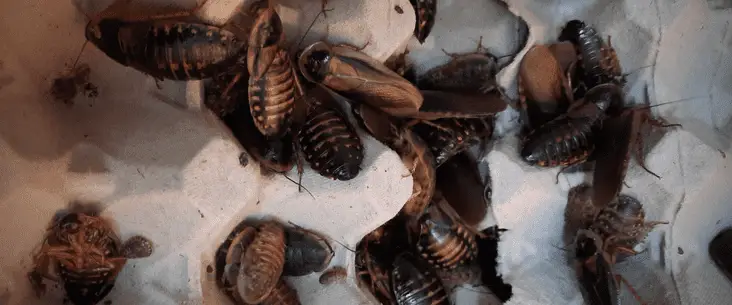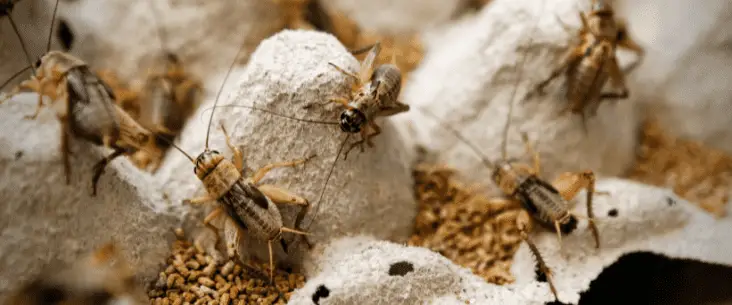Even though we tend to think of them as food for our pets, feeder insects are living animals themselves and just like any animal, we need to give them proper care as well. Many bugs eat insects, and they will refuse insects that aren’t moving or alive. To get the most out of your living food, it is important to keep them alive, healthy, and they also need to be nutritious for the animal you feed them to.
This page focus to keep and care for feeder insects, not to breed with them. When you want to breed with them, you’ll need to take more effort in the care of them. How to breed several feeder insects can be found on the pages of that specific feeder insect species, or with a link in the list at the bottom of this page.
How do you keep feeder insects alive?
Dead feeder insects will rot and quickly won’t be nutritious anymore. Also, many bugs only eat insects when they are alive. They refuse dead insects when they can not hunt them, or when can’t see them when they not move.
So the question is how you keep feeder insects alive. Let us have a look at the 5 main reasons why feeder insects die prematurely:
- Poor sanitary conditions – How is your cleaning routine? Poor sanitation cause death of feeder insects, often by the growth of bacteria and moult. You need to remove uneaten fresh food items daily. Also, dead insects need to be removed every day. Always clean the enclosure between one batch of live insects and the next one. Cross-contamination is a serious risk and can harm your insect colony and the bugs that eat them. But be aware of what you use to clean. Insects can’t handle harsh chemicals, and when chemicals are used for sanitizing, you should be sure that no chemical residue is left in the enclosure.
- Insufficient ventilation and overcrowding – Is the housing suitable for the feeder insect you keep. Proper ventilation is crucial to keep the feeder insects fresh and healthy. Also, the size of the container needs to be large enough if you keep a large number of insects. And the ventilation should be adjusted to that amount properly. Overcrowding of enclosures can be a real problem.
- Inadequate climate – Insects should be kept in the appropriate environment (temperature, humidity, light cycle). Every insect has optimal temperature and humidity ranges where they do in best.
- Insufficient or overloaded nutrition – Feeder insects need proper nutrition in the appropriate amount. They need to be fed to keep them healthy, but they also need enough food. When feeding too much, you’ll need to clean more and throw it away (also see the first of this list).
- Drowning – A problem that you mustn’t underestimate is the danger of drowning of your feeder insects. Never use a regular water bowl. Better will be to use a wet sponge or moist fruit and vegetables, at least, if they eat fruits and vegetables. With locusts, for example, bee water dispensers or bee water bottle caps work very well too.
So, when you take good care and don’t make these mistakes, your feeder insects will be alive and healthy and have the most profit of them to feed. We talk much about the terms ‘proper’ and ‘species appropriate’. Have a look at the list of most commonly used feeder insect down this page to find what the best conditions are to keep that particular feeder insect.
How long can you keep feeder insects alive?
It is no secret: insects don’t have a long lifespan. And within that time you’ll need to feed them or they will die, no matter how good your daily care is. But to give you a gn idea what the normal lifespan is of different insects I’ve summed them up in the table below.
| Feeder insect | Total lifespan | Span of stage suitable to feed |
|---|---|---|
| Crickets | 8-12 weeks | 8-10 weeks |
| Locusts | 15-18 weeks | room temp: 10 days high temp: 8 weeks |
| Dubia roaches | 64 – 104 weeks | 40 – 80 weeks |
| Mealworms | 14-28 weeks | 8-10 weeks |
| Superworms | ~52 weeks | ~ 24 months |
| Waxworms | 7-23 weeks | 4 weeks |
| Earthworms | 12 weeks | 3-4 weeks |
| Fruit flies | 5-7 weeks | 4 weeks |
| House flies | 9 weeks | 4-8 weeks |
| Black soldier fly larvae | 6-7 weeks | 3-4 weeks |
There is a great difference in the lifespan of each feeder insect, but what is most important is the optimum time that you to feed your insects. Where some have short span of the stage that they are suitable to feed (e.g. fruit flies: 4 weeks) some will have a much longer span in which you can feed them (e.g. dubia roaches: 40-80 weeks in adult stage, but can be fed already in nymph stage).
Are your feeder insects dead of going into next life stage earlier than the span noted above? It can be that the animals are already some time in that feeding stage. For some animals it would be better to buy them in (some) stage(s) before the stage you feed them, as you can do with crickets, for example, to have the most time to feed them and not die before you fed them.
How do you keep feeder insects nutritious?
When we look at nature, insects that are consumed by, for example, reptiles are delivering the vitamins and minerals they’ve assimilated into their tissues directly to the ones that eat them. Conversely, insects commercially bred have been on a diet that is designed to grow insects quickly and make them better reproducing. This diet made them void of the crucial levels of vitamins and minerals for the animals you want to feed the insects to.
When you aware of that you’ll understand that feeder insects must be nutritionally improved. To make them more nutritious, you have two common methods: dusting and gut-loading.
Dusting is literally coating feeder insects with powder containing these crucial vitamins and minerals right before feeding them to the animal.
Gut-loading is the process of enhancing the nutritional value of feeder insects by feeding the insects high valuable diets containing these crucial vitamins and minerals. You can create this high valuable diet yourself or by a specialized insect diet for this purpose. As a result, their gastrointestinal tract is filled to make them more nutritious.
In the comparison table below you can find the nutritional values of the most used feeder insects.
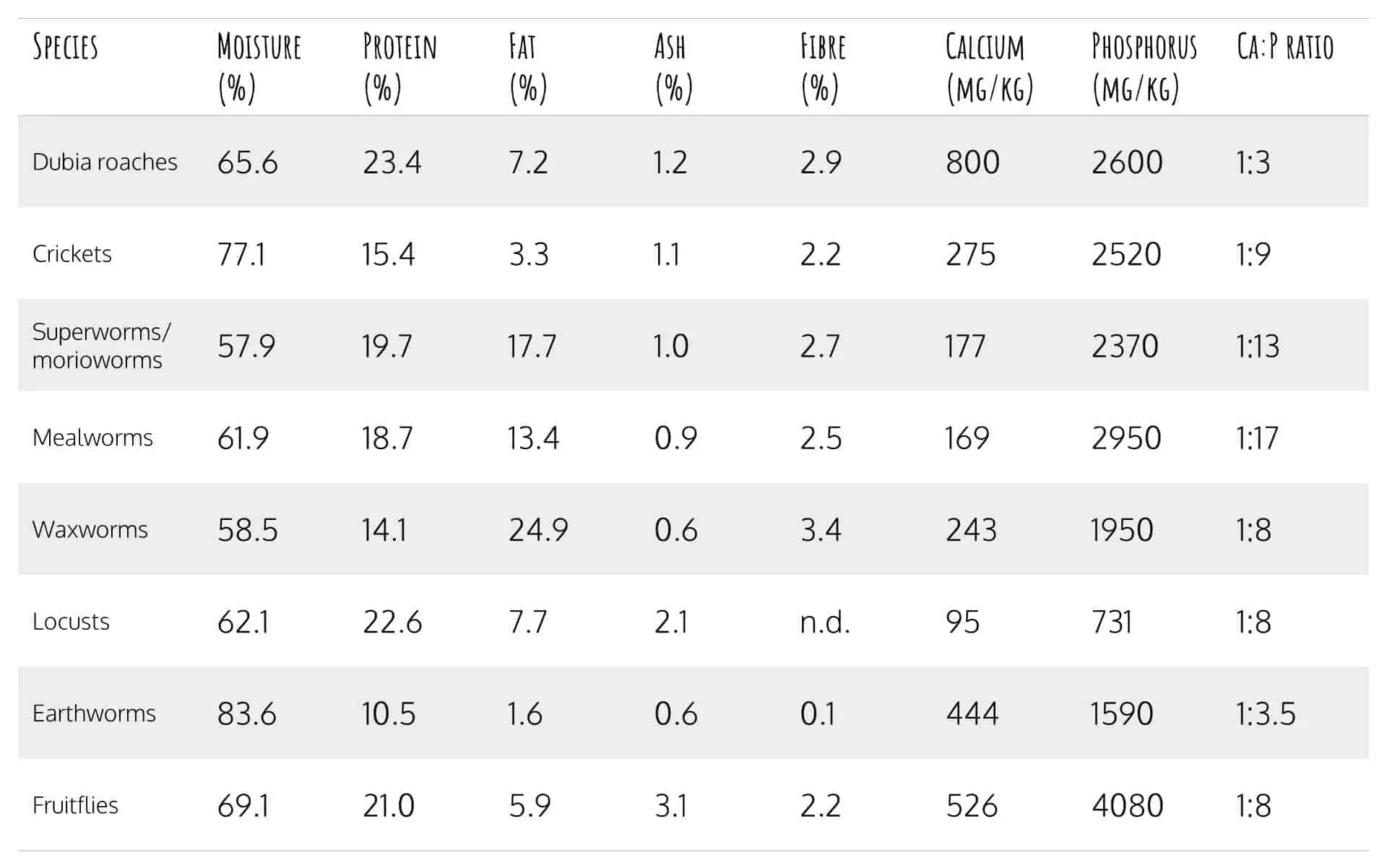
Can you put feeder insects into the refrigerator?
There are species that you can put in the refrigerator to extend the quality of the insect as a food source, some are even highly recommended. Others are not suitable to put in a refrigerator and will quickly die if you do so.
Always check the animals how they develop when you do so, even if it is highly recommended. Maybe your refrigerator is too cold. You also need to take into account where you put the insects in the refrigerator because not all spots are evenly cold.
I will give you an overview of which insects are suitable or even recommended to put in the refrigerator in the table down below.
| Feeder insect | In refrigerator | Notes |
|---|---|---|
| Crickets | Deathly/not recommended | Don’t survive cold temperature |
| Locusts | Deathly/not recommended | Don’t survive cold temperature |
| Dubia roaches | Deathly/not recommended | Don’t survive cold temperature |
| Mealworms | Recommended | Will delay development into pupae |
| Superworms | Deathly/not recommended | Don’t survive cold temperature |
| Waxworms | Recommended | Will delay development into pupae |
| Earthworms | Highly recommended | They do better in cold temperature |
| Fruit flies | Deathly/not recommended | Don’t survive cold temperature |
| House flies | Partly recommended | Only delay egg development a put in the refrigerator for maximum of one week |
| Black soldier fly larvae | Deathly/not recommended | Don’t survive cold temperature, pre-pupae can survive in cold an delay development |
The care for feeder…
For most bugs, live feeder insects are the only appropriate food items they need. Fortunately, there are several feeder insects you can use to feed your pet, depending on which species you have.
Some insects work better for one bug species than others. But they all have in common that they need to healthy and properly fed. Good care for your feeder insects is vital for the nutritious value of your feeder insects.
Here is a list of the most common live feeder insects and how to take care of them to keep them healthy and nutritious.
Crickets

Related read: A Practical Guide How-To Breed Crickets
Housing
Best is to house them in a plastic container or a cricket pen. Make sure you use a lid because crickets can jump pretty well and would otherwise escape. When you use a plastic container, you’ll need to make ventilation holes and cover them with fine metal mesh.
Place egg flat or toilet paper rolls to increase the surface size of your enclosure so you’ll be able to house more, but also for the crickets to get out of each other’s way.
Climate
Keep crickets prefably between 15°C and 20°C.
Nutrition
A healthy diet makes crickets a healthy food source. Fresh fruits and vegetables are ideal as a food source and also provide water for them —for example; Potatoes, carrots, broccoli, romaine lettuce, apples. Avoid feeding them citrus, banana, kale, iceberg lettuce, watermelon, and nightshade.
In addition, give them dry food such as cricket chow, crushed cat or dog food, or chicken feed (vegetable-based). Dry food provides many essential nutrients and makes them healthy.
Quick tips
Clean the container at least once a week or between cricket shipments.
Toilet roll tubes can be used to remove crickets from your container to feed them. Use a small box or plastic bag and shake a toilet roll into this box or bag until you have enough crickets. This way, you minimize the risk that crickets escape from your enclosure.
Locusts
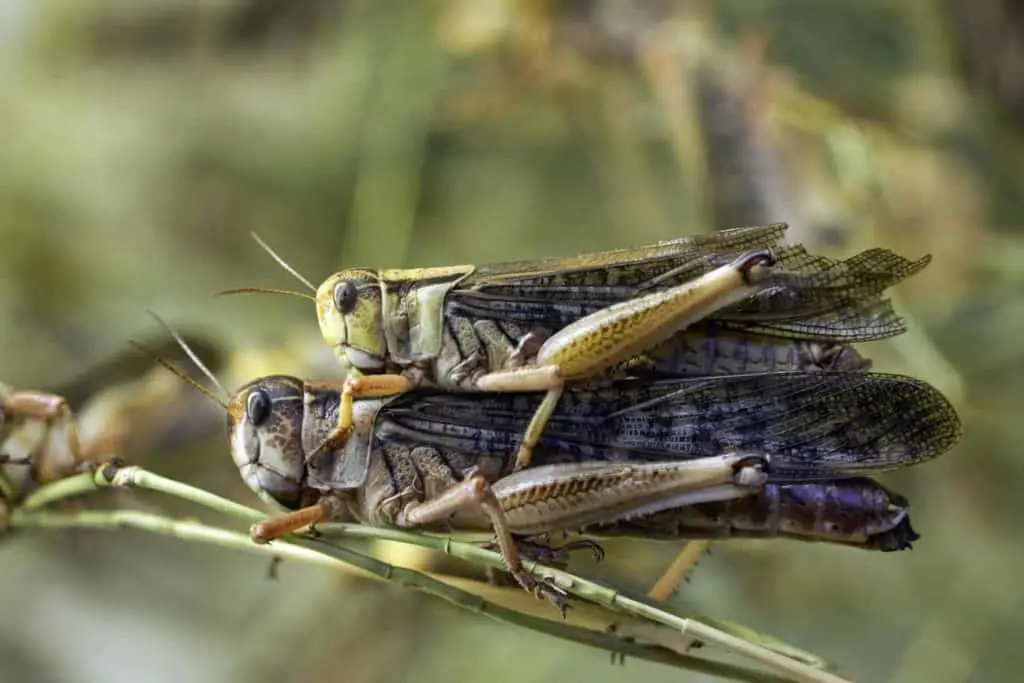
Related read: A Practical Guide How-To Breed Feeder Locusts
Housing
Locusts can best be housed in a large plastic container with a size of at least 40x40x40cm. You need to cover the container with a lid so they don’t escape. The lid need to have holes in it so you have enough ventilation. Good practice would be if you put some climbing material in the container. This material will also increase to total surface of the container.
Climate
Locusts can best be kept at a temperature of 15°C and 20°C when you only keep them until you feed them. Try to keep the locusts very dry (low humidity).
Important! If you are keeping locusts at room temperature, you should not feed them at all. Food that they eat with this temperature will not be adequately digested and will decompose in their stomach. The result of this process is that locusts will become ill and die.
Nutrition
Locusts eat grasses, so it would be best to feed them grass daily. When not available bamboo can also be used. You could also greenery. You need to figer out what greenery the locusts eat, if it is not sprayed or poisenous. Locusts are sensitive for chemicals.
Green and leafy vegetables could be used as well, all the best would be that you feed them green foliage.
To make locusts a better food source it would be good to feed them high protein food such as bran or chicken breeding meal. A special insect food would work as well.
Quick tips
If you’re concerned about the locusts jumping everywhere, you can put them in the fridge 30 minutes before a feed, and they are more docile and can easily be picked up.
Dubia roaches
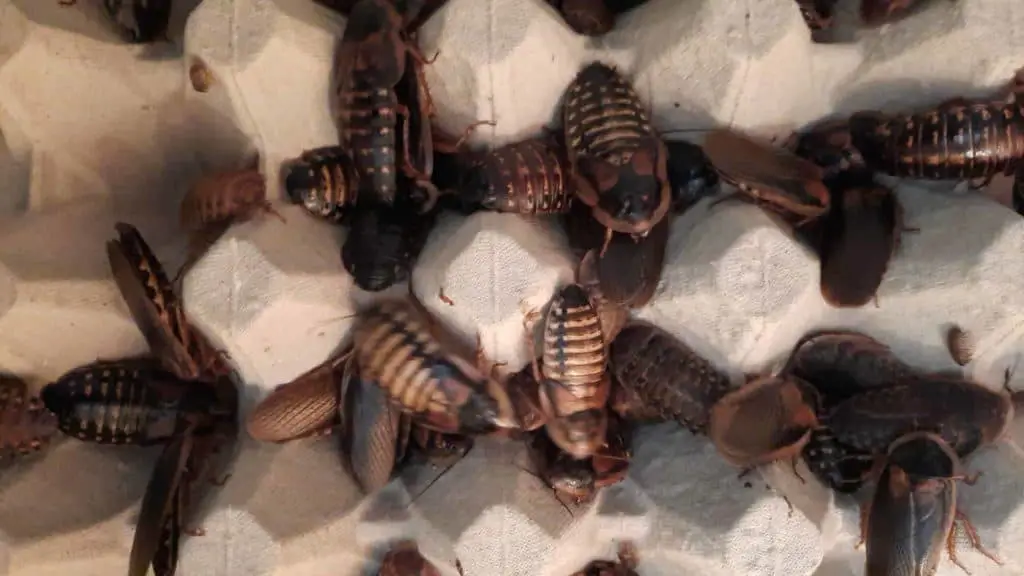
Related read: A Practical Guide How-To Breed Dubia Roaches
Housing
The best way to keep dubia roaches is in a plastic container with a smooth edge surface. This way, they can’t climb out. You can also use a lid to prevent escape, but they need proper ventilation holes. It would be good practice to give them egg flats or carton plates to climb on and shelter for light and to make them feel safe.
Climate
To house them as feeder insects, the best temperature would be between 20°C and 25°C. If you wish to breed with them, you’ll need higher temperatures around 28-29°C. Never place dubia roaches in direct sunlight!
Be aware of high humidity levels because it may cause bacteria and mould growth.
Nutrition
Feed them a diet that contains dry bread, carrot, apple, oranges. Please don’t feed them to many proteins because roaches assimilate proteins in their bodies in the form of uric acids.
Quick tips
When you use egg flats, place them vertically so the frass (roach faeces) will fall down, keep it cleaner and that moisture doesn’t accumulate.
When you mostly feed the males, you’ll keep enough females to breed for a while. The best breeding ratio is 1:3 to 1:7 male:female ratio.
Because dubia roaches breed very easy and have a high reproducing rate, it is very interesting to have your own breeding colony to feed your animals.
Mealworms
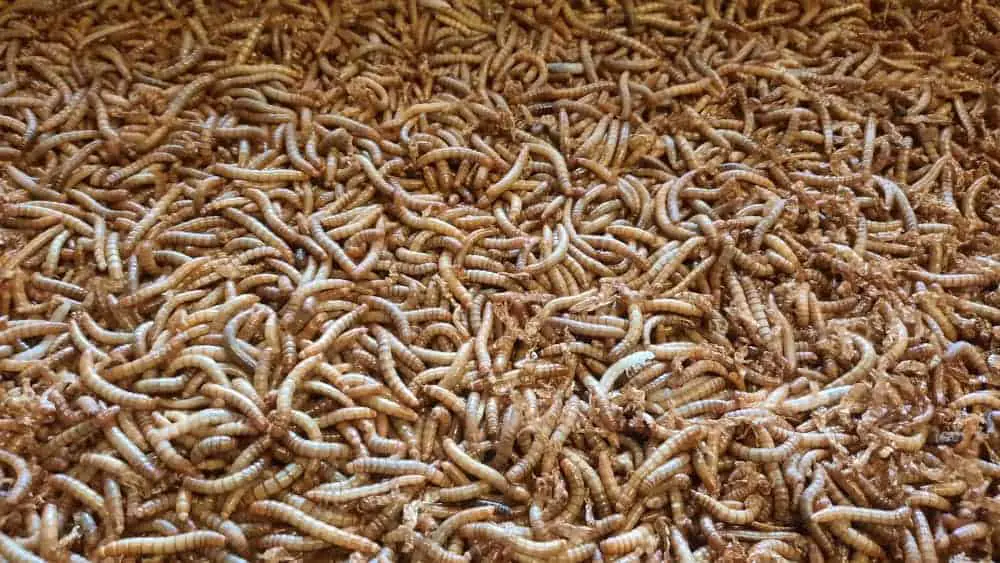
Housing
You should house mealworms in a plastic box. When you do not keep mealworms in a refrigerator give them enough space and surface (for example with egg carton). They can be housed in an open-top container with smooth sides. Use a lid with enough ventilation holes to prevent pests (e.g. mice or birds) from eating them.
Climate
Recommend to house them in a cool area, preferably a refrigerator, at a temperature between 5°C and 7°C to keep them for a longer time in the larvae form. When not kept in the refrigerator, keep them out of direct sunlight. Direct sunlight may cause rapid transformation into pupae or overheating, which in case of overheating will result in death.
Nutrition
Provide mealworms dry food such as bread (whole-wheat) or bran, and give them a fresh piece of apple or carrot every other day. Please don’t provide food with much moisture to prevent the growth of mould. Only give them new food when the previous portion is wholly eaten.
Quick tips
It is recommended to gut-load mealworms one day before they are fed to the animals. Keep the amount that you want to feed separate and provide them with the food to gut-load them. Gut-loading works best outside the refrigerator.
Superworms/morioworms
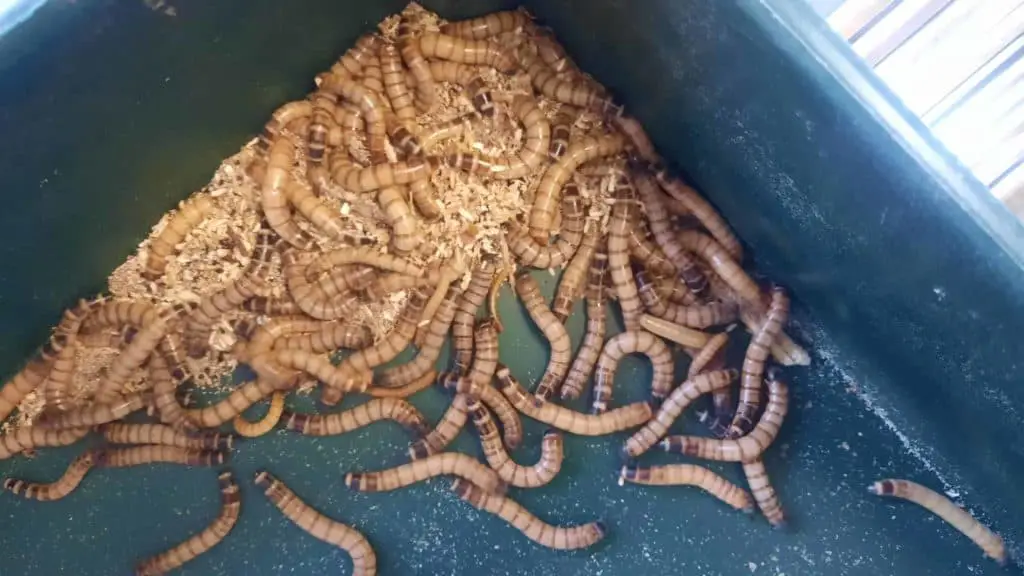
Related read: A Practical Guide How-To Breed Superworms
Housing
Place them in a plastic container. You can use open-top containers with smooth sides, so they have maximum fresh air. If you use a closed container, provide enough ventilation. Lids can be advised when you have pests that eat the worms (e.g. mice, birds).
Climate
Store them with a temperature between 15°C and 20°C. They need to be kept dry to avoid mould and bacteria growth.
Nutrition
Provide the superworms dry food such as bread (whole-wheat) or bran, and give them a fresh piece of apple or carrot every other day. Don’t provide food with much moisture to prevent the growth of mould. Only give them new food when the previous portion is wholly eaten.
Quick tips
In contrast with mealworms, never keep superworms in the refrigerator.
It is recommended to gut-load the superworms one day before they are fed to the animals. Keep the amount that you want to feed separate and provide them with the food to gut-load them.
Waxworms
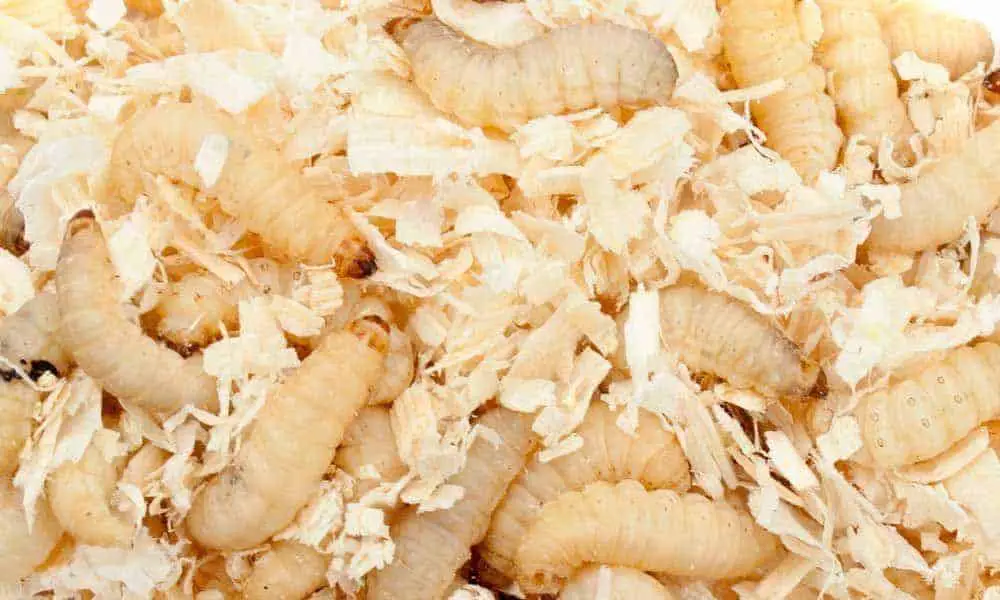
Housing
You can house wax moth in simple plastic boxes (often the transport packaging). Be sure that they are housed on wood shavings.
Climate
Keep wax moths between 10°C and 15°C and never keep them in direct sunlight. Overheating of wax moths may quickly result in death. Also, keep them as dry as possible. They can’t handle too much moist/damp, especially with higher temperatures.
Nutrition
You can give them a piece of bread (whole-grain) soaked in honey for extra nourishment until they are fed.
Earthworms
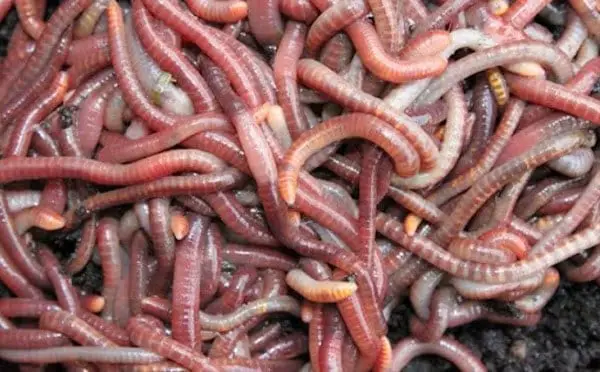
Housing
Earthworms need to be housed in a dark place. Best would be to use a small plastic box and add some soil in it. Don’t use soil that is heavily fertilized.
Climate
Earthworms prefer colder climates. Best would be to keep them between 5°C and 7°C. So, placing them in the refrigerator would be highly recommended.
Nutrition
They can live and feed on the soil. It is recommended to dampen the soil once in a while, but avoid the soil to become wet and the growth of mould in it.
Quick tips
When you feed earthworms, you’ll need to rinse them off with water before feeding to remove any soil off the worm. Soil can give problems to the digestive tract of the animal that eats them.
Which insects are not suitable as food?
When it comes to using insects as a food source, the option will be limited to commercially available insects. These insects are proven to be good and healthy to use as food source.
Wild-caught insects can either be poisoned, be poisonous and often carry unwanted parasites. Beetles, centipedes, ants, bees & wasps, butterflies and fireflies are not suitable to use as feeder insects. For example, beetles have a hard exoskeleton, and many animals don’t like the taste of beetles.
Not all feeder insects are suitable for every animal. Always check what would be the best food for the animal you want to feed. Some commercial insects have a high-fat percentage and low calcium values. For example, mealworms, superworms and waxworms are very high in fat and not always suitable for every animal.
Share this page!

